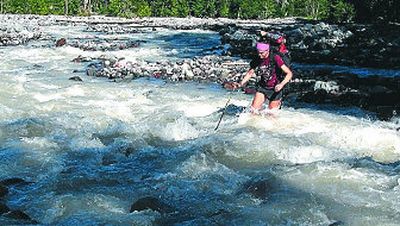Spring unveils peril for hikers

Hiking dangers resulting from storm damage to trails and bridges in the Cascade and Olympic mountains will continue well into summer, officials say.
Severe storm damage already has been linked to two deaths during early-season hiking in Mount Rainier National Park.
Flooding has washed away many footbridges, and numerous streams and rivers are running high in new channels or foaming around freshly deposited boulders and fallen trees and branches, officials in Mount Rainier and Olympic national parks said.
“It’s going to be much different out there for hikers this year,” swift water rescue instructor Tom Minor said.
Hikers should contact rangers before leaving and remember that while snow may be gone from lower elevations, there may be several feet still melting higher up the slopes, said Barb Maynes, Olympic park spokeswoman.
“We’re urging people to be really flexible with their trip planning,” Maynes said. “If their favorite trail isn’t accessible, we want them to choose somewhere else. If they get out there and a bridge is out, they should turn around and go someplace else.”
The most common danger in crossing rivers is slipping, even for experienced hikers when rivers and trails are in normal condition, said Steve Klump, the Mount Rainier wilderness district ranger.
Fall and winter storm damage at Rainier from washed-out campgrounds, roads, bridges and trails has been estimated at $36 million, and most of the park remains closed to motorists.
When bridges and footlogs over rivers and streams are washed away, the decision becomes whether to try to find a way across or turn around.
“There are a ton of factors to consider before crossing, but basically it boils down to experience,” Krump said. “We are not encouraging anybody to cross unassisted.”
The urgency of the question was highlighted with the March deaths of Robert and Frances Annette Blakely, 44 and 47, of Puyallup.
A footbridge linking Ipsut Creek Campground, their favorite, with the Rainier park entrance was gone, so the Blakelys and a companion went north to try pick their way through fallen trees across the high-running creek, said Patti Wold, a park spokeswoman.
Frances Blakely slipped on the log they chose to cross and fell into the frigid water. Her husband jumped in to try to save her and both were swept downstream to their deaths.
“I fear that there are going to be more incidents like this all over the Cascades when people get out there and see how dramatically their favorite trails have been impacted,” Minor said, “and especially at Mount Rainier, where there is so much damage.”
At least 10 bridges are known to be out on Mount Rainier’s Wonderland Trail, the popular 94-mile route around the mountain.
Elsewhere, according to the Washington Trails Association:
“A suspension bridge was destroyed on the Buck Creek Trail over the White River in the Mount Baker Snoqualmie National Forest.
“Access to trailheads of the Green Mountain Trail, Downey Creek Trail, and Huckleberry Mountain Trail are inaccessible by car because of major washouts on the Suiattle River Road.
“The Big Four Ice Caves near Darrington are inaccessible because of damage to the trail bridge over the south fork of the Stilliguamish River.
These are just examples of much more damage, WTA officials say. Much more damage is likely waiting to be discovered under a blanket of snow.